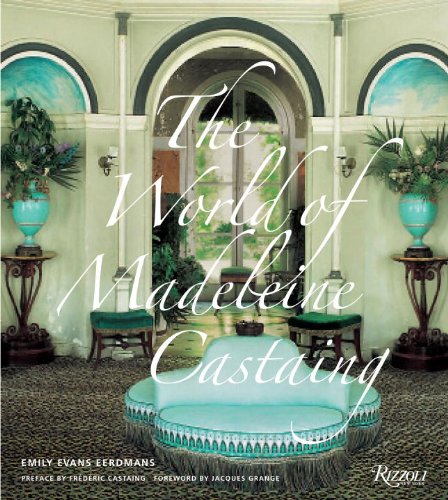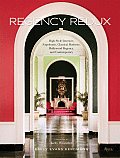A wall applique in the form of a Phyrgian helmet designed by Thomas Hope
In fact, I have been bursting at the seams to show you this table which I first encountered on a tour of Carly's gallery months ago.
A royal porcelain demi-lune table by Bellangé, c. 1820, from Carlton House. Note how it's photographed in front of a mirror so that its reflection completes the ellipse.
It was installed in the Prince Regent's fabled Carlton House whose late Louis XVI-inspired decor of the 1790s set the London beau monde on fire. The Prince, later George IV, earned a deserved reputation for extravagance and large sums were spent on constant redecorating. This table was acquired in 1822 for the Blue Velvet Room when the full-blown stylings of Walsh Porter had the monarch in its clutches.
The Blue Velvet Room, Carlton House, as painted by W.H. Pyne in 1818 - yet another scheme before the table was purchased
I was sworn to secrecy until now, as the table was being officially unveiled at this show. But this is only the tip of the iceberg.
Regency aesthete and designer Thomas Hope in Turkish costume
Hope's Egyptian Room at Duchess Street. The Flaxman illustrations don't convey the brilliant color scheme of pale yellow and bluish green of the Egyptian pigment, relieved by masses of black and of gold"
Thomas Hope design for a wall light, left, and the carved and bronzed limewood wall light itself, c. 1802
Hope was so pleased with the results, he commissioned John Flaxman to illustrate the interiors which were published in 1807 as Household Furniture and Interior Decoration. As Hewat-Jaboor has pointed out, Hope's ultimate mission was to improve taste and what better way than to lead by example.Hewat-Jaboor also highlights Hope's lesson of combining new works with antiques, which he believes is as important in today's interiors as it was for Hope's. “You have to present things in a fabulous and exciting way, and that means there has to be a mixture of the very best – new and antique. You have to see how objects interact as a whole. It’s the fusion of paintings, objects and furniture that makes everything come alive."
Hewat-Jaboor's previous London flat with a pair of predestals and settee, both from Duchess Street and now on view at Carlton Hobbs
"Inspired by Antiquity" runs through February 18th
Carlton Hobbs
60 East 93rd Street
New York, NY
Tomorrow: More on Philip Hewat-Jaboor, the aesthete behind the aesthete
For more on the exhibition, click over to 1stdibs and the Huffington Post.















10 comments:
Fabulous! I am a huge fan of Thomas Hope and these classical furnishings are awe-inspiring!
That was the best kind of Valentine, dear EEE.
The images of Philip Hewat-Jaboor's rooms in your
book Regency Redux, intrigued me no end~and now
this post about Thomas Hope. Many thanks!
It doesn't happen often, but the Dilettante is both aflutter, and speechless. Just divine.
Thomas Hope's authentic swagger is what captivates me; the look of his work, however glamorous, is always strongly, swaggeringly masculine, a characteristic so often overlooked and underappreciated in interior design. Strength is beauty, and Hope aced it.
First there is heart. Now there is Hope. Too bad today's instant billionaires don't have the vision AND the style to pull this off. The table alone sent me into de-fib.
I'm now completely in love with Thomas Hope. The helmut wall applique is amazing. I hate I won't be able to make it to this. Thank you!
Dear EEE: At your recommendation I visited Carlton Hobbs today, and saw this show. Jaw dropping. Mr, Hobbs couldn't have been nicer or welcoming, or accommodating. The show was astonishing, and the setting, a meticulously restored Vanderbilt neoclassical limestone mansion, was amazing. Ducal, really. Thank you. Reggie
I can't ever get emough of Hope...did you make it to that great exhibit at the V&A back in 2008- Thomas Hope: Regency Designer? I know you would have loved it... I was lucky enough to be there my chance.
For those who like Hope's work, you have to check out David Watkin's book Thomas Hope: Regency Designer. It is gorgeous and scholarly.
The New Republic had a good review of it a while back too, though I am not sure if it is behind a paywall now or not.
Brendan, You are absolutely spot on. The Thomas Hope exhibition catalogue is masterful and a must for any design historian's library. In fact, it was PHJ's passion for Hope that was the major force in the evolution of the show.
According to one of the essays, Hope was often mocked by society and when a romantic novel he wrote under a pseudonym became a raging success, no one could believe it was Hope who could write something so popular (many thought Byron was the author). Of course, not being appreciated in one's own time puts Hope in excellent company.
Post a Comment